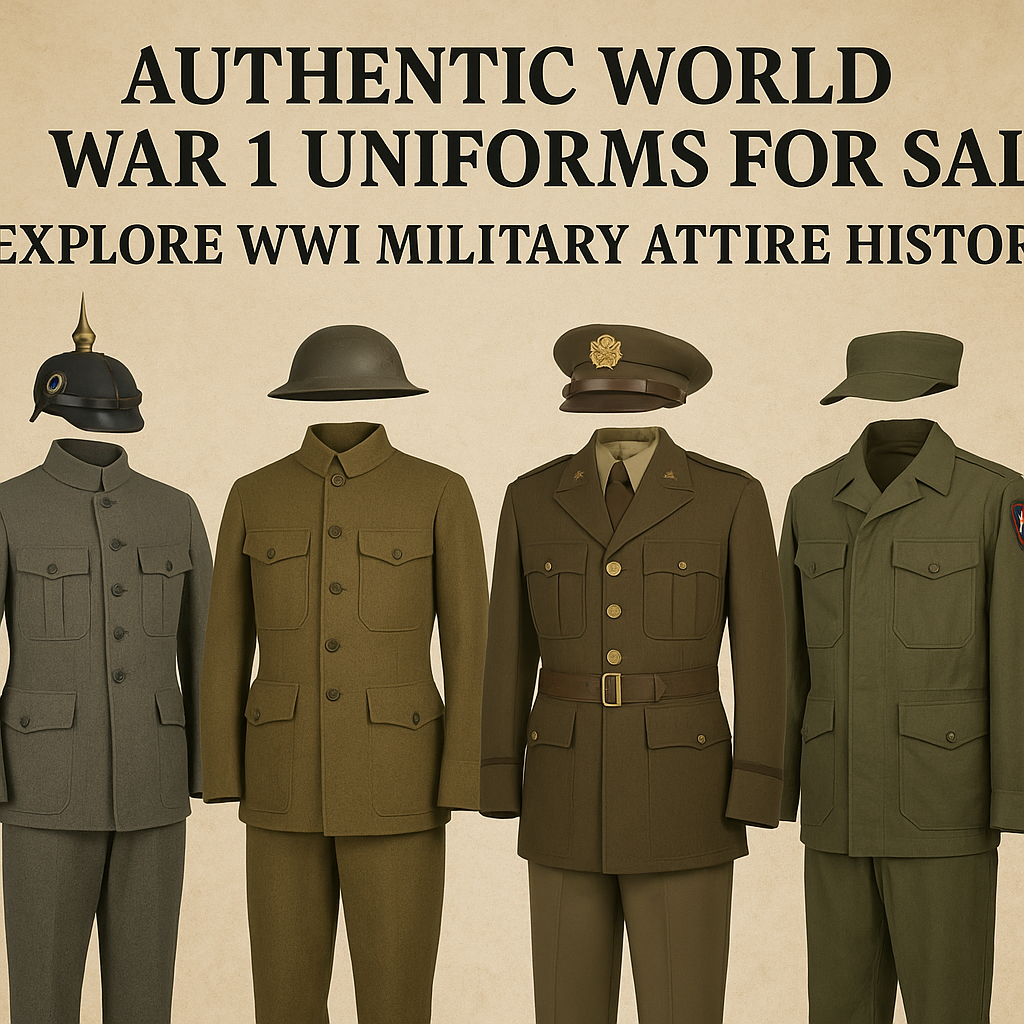
Authentic World War 1 Uniforms for Sale: Explore WWI Military Attire History
Published on Jul 01, 2025
Introduction: Why World War 1 Uniforms Still Matter
World War 1 uniforms represent a turning point in military fashion and functionality. As the Great War redefined combat with trench warfare, chemical attacks, and mechanized infantry, military gear evolved rapidly. At Paddelaters, we preserve this era through authentic reproductions and collectibles—from the classic U.S. Doughboy WW1 uniform to the distinguished German WWI cap.
Whether you're a military collector, reenactor, or simply intrigued by history, understanding the importance of First World War uniforms deepens your appreciation of the past—and ensures you invest in garments that are historically accurate and valuable.
1. WW1 US Uniforms: The Iconic Doughboy Look
The American soldier, or "Doughboy," wore a uniform that became symbolic of America's late but decisive involvement in WWI. The U.S. Army adopted a practical and rugged outfit designed to endure harsh trench conditions.
Key Components of the WW1 US Uniform:
- M1917 Field Jacket: Woolen and olive-drab, the M1917 became standard issue and offered warmth and durability.
- Trousers and Puttees: Tightly wound cloth leggings known as puttees protected the legs from mud and cold.
- Doughboy Helmet: Officially the M1917 Helmet, it was inspired by the British Brodie design and provided head protection from shrapnel.
- Boots: Trench boots made of rough leather were reinforced to endure waterlogged trenches.
Why it Matters Today:
Collectors value the U.S. Doughboy WW1 uniform for its historical accuracy and unique American military identity. Reenactors especially seek quality reproductions to bring history alive in parades, museums, and educational events.
2. German WW1 Uniforms and the Historic Pickelhaube
Germany’s WW1 military attire was distinct and complex, reflecting Prussian influence and the empire's deep military traditions. One of the most recognized accessories is the German WWI cap, or Pickelhaube, a spiked leather helmet worn during early WWI years.
German Uniform Features:
- Field-Grey Tunics: Known as “feldgrau,” this color was introduced for camouflage.
- German WWI Cap / Pickelhaube: Early war versions were made of boiled leather with a metal spike; later replaced by the sturdier Stahlhelm.
- Medals & Badges: Iron Crosses and rank insignia were often sewn or pinned to the tunics, offering collectors valuable detail.
- Jackboots: High leather boots that came to symbolize German infantry.
Modern Appeal:
The German WWI cap remains highly collectible, especially originals and well-made replicas. Many military history fans love to own or display these iconic items for their craftsmanship and cultural significance.
3. First World War Uniforms for Sale: What to Look For
When shopping for First World War uniforms for sale, it's essential to consider authenticity, material quality, and historical accuracy. At Paddelaters, our inventory is carefully curated to reflect real wartime apparel—either as original antiques or faithful reproductions.
Tips for Buying WWI Uniforms:
- Check for Authentic Fabric: Wool, leather, and canvas were standard in WWI uniforms.
- Inspect Insignia: Accurate placement and design of rank patches, unit badges, and medals can increase value.
- Reproduction vs. Original: Originals may be fragile and expensive; quality reproductions are ideal for wear and display.
- Research Provenance: Knowing where and when the uniform was used can enhance its historical value.
Whether you're after a Doughboy WW1 uniform, German WWI cap, or an entire combat-ready outfit, investing in quality gear makes all the difference.
4. Bridging Eras: The 1950 Army Dress Uniform & Korean War Gear
Though not WWI, the 1950 army dress uniform and Korean War uniforms (US Army) continue the legacy of early 20th-century military fashion. These items reflect how WWI influenced modern military dress.
1950 Army Dress Uniform:
- Worn in the early Cold War years.
- Included tailored olive-drab jackets, ties, and service caps.
- Often adorned with service ribbons and branch insignia.
Korean War Uniforms (US Army):
- Utilized M1951 field jackets and updated cold-weather gear.
- Carried over elements from WW2 and earlier conflicts, blending functionality with new tactical demands.
Why Collectors Care:
These uniforms act as a bridge between World War 1 and the modern battlefield. They’re ideal for those interested in the evolution of U.S. military dress.
5. How to Preserve and Display Military Uniforms
Whether you're collecting for investment, education, or passion, preserving WW1 uniforms is vital.
Preservation Tips:
- Store in a dry, cool place away from direct sunlight.
- Use acid-free garment bags or display cases.
- Avoid excessive handling—wear cotton gloves if possible.
- Clean with care; consult a textile preservation expert before any washing or treatment.
6. Why Buy from Paddelaters
At Paddelaters, we don’t just sell military uniforms—we preserve history. Every item in our collection is carefully selected for quality, accuracy, and storytelling power. Whether you're a seasoned collector or just starting out, our WW1 and Korean War uniform collection offers unmatched value and authenticity.
Benefits of Buying from Us:
- Trusted source for First World War uniforms for sale.
- Wide variety including Doughboy WW1 uniforms and German WWI caps.
- Expertise in sourcing, restoration, and historical accuracy.
- Great for reenactors, museums, and military heritage fans.
Conclusion: Carrying History Forward, One Uniform at a Time
World War 1 uniforms are more than fabric and buttons—they are tangible links to the past. Whether it’s the grit of the trenches in a Doughboy uniform or the iconic silhouette of a German WWI cap, each piece tells a story. As interest in military history grows, so does the importance of preserving and sharing these artifacts.
Explore our full collection today at Paddelaters.com and take home a piece of history.
